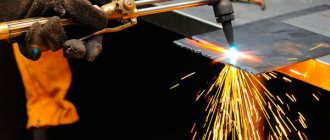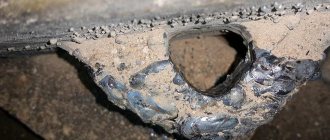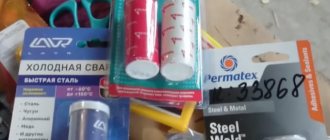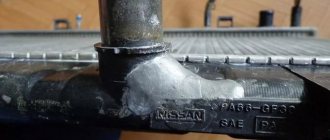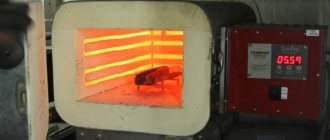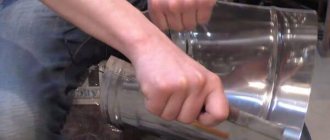Characteristics and composition of cold welding
The main characteristics of cold welding are:
- Presence and composition of filler.
- The initial drying time is the so-called time. “setting”, during this time the composition must be applied to the gluing area and leveled.
- Final curing time - the product cannot be used before this period.
- Application temperature - the recommended temperature at which the mixture can be applied to the surface.
- Maximum operating temperature.
The plastic cold seal adhesive composition can consist of one or two components. Its required components are:
- The adhesive base is in the form of epoxy resin, which determines the plastic properties.
- The filler is metal powder, evenly distributed throughout the volume.
- Quality improving additives, such as sulfur.
The quality of a weld obtained by cold welding depends on conditions such as:
- Quality of adhesive material.
- Preparing the surfaces of parts for gluing.
- Compliance with technology.
The strength of the resulting seam in real conditions will be lower than that of a seam produced by the hot method.
Therefore, the technology is best applicable for local repairs of lightly loaded products.
Overview of popular varieties and method of application
There are different types of cold welding available for different materials. There are universal compositions that are suitable for metal, plastic, glass, ceramics, concrete, wood and stone. However, there are also highly specialized types of glue intended only for metal or only for plastic surfaces.
For working with metal
Cold welding grades for gluing metal:
- "Poxipol". Universal two-component adhesive "Poxipol" is intended for welding metal, plastic, concrete, glass, rubber. After polymerization, “Poxipol” becomes as hard as metal and can even be drilled. Operating temperature – from -50°С to +120°С. This composition is moisture resistant, it can be used for welding water pipes, repairing sewers, drains, and swimming pools. “Poxipol” hardens even under water.
- "Mastix". Designed for gluing, repairing, sealing parts made of ferrous and non-ferrous metals. "Mastix" hardens very quickly - fixes the connection in 10 minutes. It is frost-resistant, it can be applied even at temperatures down to -10°C, which allows you to work with it outdoors in the cold season.
- "Diamond". This universal welding is suitable for ferrous and non-ferrous metals, plastics, glass, ceramics, wood, concrete, stone. It has high adhesion even when used on oily surfaces - for example, it can be used to repair fuel tanks.
- "Oskol" This type of welding is intended for gluing various types of metals, including alloys: steel, brass. Like Almaz, Oskol can be used on wet and oily surfaces, so it is used in plumbing work and when repairing cars.
- "Abro Steel". This glue is suitable for welding metals and their alloys. When hardened, it expands in volume, filling voids, so it is used to seal cracks. Resistant to water, used for repairing water transport and pipes.
How to use cold welding correctly
To obtain a good seam, careful execution of the following steps is of utmost importance:
Technological process of cold welding
- Clean the bonded surfaces from oil, fat and mechanical contaminants. Cleaning can be mechanical (abrasives, steel brush), chemical (solvents and degreasers) and combined.
- All actions are carried out only in protective gloves.
- Squeeze the two-component composition out of the tubes and mix the components well.
- Separate the required amount of plasticine-shaped composition from the block with a spatula and carefully close the remaining block.
- Knead the composition. It should heat up slightly, maintaining plasticity; once the required consistency is achieved, apply the mixture to the surfaces to be glued.
- Securely press the surfaces together by wrapping the parts with an elastic band.
- If pipes are being repaired, the composition must be applied with several smoothing movements.
- After the time specified in the technical specifications as the initial drying time (90% of the glue sets), the tourniquet can be removed.
- The repaired product can only be used after the final hardening time has passed, usually 24 hours.
It is better to remove the remaining adhesive with a spatula after applying and applying the tourniquet. If they have already hardened, they can be removed by lightly tapping them with a hammer.
Rules of use (temperature of application and operation, electrical conductivity, etc.)
Operating rules are always specified in the instructions for use of a specific composition. Before performing welding work at home, you need to carefully familiarize yourself with them. However, there are general rules of use that apply to all brands:
- The bonded surfaces must be carefully processed. It is cleaned of dirt and treated with an abrasive material, such as sandpaper. Then degrease with a solvent - white spirit or acetone.
- The next stage is preparing the glue. If it is a one-component composition, you need to knead the bar a little in your hands until it softens slightly. To prevent the material from sticking to your hands, they are slightly moistened with water. The two-component composition is mixed in proportions according to the instructions.
- The epoxy composition is active for 3 minutes. During this time, you need to have time to apply it to the surface to be treated and carefully level it.
- To ensure the strength of the connection, the two parts are placed under a press and clamped in a vice or clamps. If you don’t have such equipment at home, you can simply place a heavy object on top.
- The glue takes several hours to dry. The exact hardening time depends on the brand of the substance and is indicated on the packaging. It is recommended to use the product at least 24 hours after welding.
Cold welding should be used at a temperature not lower than +5°C. The maximum air temperature should not exceed +35°C, despite the fact that the composition can withstand sudden temperature fluctuations.
The electrical conductivity of cold welding depends on the type of substance. If the composition contains a special filler, then the product has this property.
Temperature characteristics
The composition of the adhesive mass determines what temperature cold welding can withstand. The user manual always states this value. If you carefully follow all the requirements of the manual, the seam will withstand this temperature without loss of strength.
Budget brands are usually developed for a maximum temperature of around 260 C. Special types of mixtures have a maximum operating temperature of over 1300 C. They cost significantly more, but they allow you to repair parts and products operating at high temperatures. This is an excellent help if the use of hot technology is difficult for reasons of fire safety or accessibility of the repair site.
Application area
The heat resistance of the adhesive determines the scope of application:
- Household. Repair of heating radiators, gas boilers, water heaters, stoves, pots, kettles.
- Automotive . Repair of all vehicle components that are exposed to high temperatures: cooling systems, exhaust gases and engine.
Important! A modern engine is a high-tech unit. Without professional skills, you should not carry out repairs. Before using cold welding to repair an engine, we recommend consulting with specialists
Types of cold welding
The following types are used:
- Spot. For connecting aluminum and copper conductors, gluing copper ends to aluminum wires.
- Suture. For the production of thin-walled vessels, sealed containers and equipment casings.
- Butt. For connecting wires or ring-shaped products.
- Tavrovaya. For connecting elements of rolled profiles.
- Shifting. For connecting pipes of heating or water supply circuits, as well as components of electrical distribution networks on railways.
Depending on the packaging method, there are:
- Liquid Weld - Supplied as two separate components, a plasticizer and a hardener, which are mixed before use.
- Plasticine-shaped, supplied in the form of a bar, which is kneaded and mixed before use.
Two-component cold welding is more difficult to use, but is more economical in use.
Plasticine cold welding
Liquid cold welding
According to their intended purpose, they are distinguished:
- liquid welding for metal is used for gluing most metals and contains a filler in the form of metal powder;
- liquid welding for car repairs, characterized by increased resistance to vibrations, also contains a filler;
- universal, connecting metals, wood or plastic in any combination. The strength of such a connection will be low;
- for work in special conditions, such as underwater, high-temperature, aggressive environments, etc.
Heat resistant cold welding
Heat-resistant cold welding is very popular among car enthusiasts who repair mufflers and other exhaust system elements.
Definition, purpose
In this article we will take a detailed look at such a universal and modern tool as “Cold Welding”, describe in detail the areas of application and analyze all the nuances when using it. Many ordinary people, having heard this definition, probably become confused - what is it and how can welding even be “cold”? Essentially, this is a special adhesive putty used to connect various parts, based on epoxy resin and filler, which is responsible for strength and heat resistance. The metal powder in the filler makes the seam, after it dries, look like a weld. This is where it takes its name from.
I want to say right away so that you don’t get confused in the future, such a concept as “Cold welding” is also found in industry, where soft metals are joined under high pressure; this technology, except for the name, has nothing in common with our glue.
This product is widely used in the field of repair work during the operation of transport, pipelines of heating systems, water supply and plumbing. Simplicity and efficiency in operation, without the use of special equipment, allows you to quickly and efficiently deal with problems that arise.
Cold welding does an excellent job of eliminating holes and holes, for example in a gas tank, radiator, muffler and other small defects on metal surfaces; it can also be used to restore threaded connections by creating copies of the missing bolts - to do this, just sculpt the desired shape and, while the mass did not have time to harden, cut the thread with a regular nut.
It is worth noting that this type of welding is optimal in conditions where the parts being joined do not bear heavy loads during operation. Unlike a traditional seam made by a professional welder, the adhesion produced by cold welding will be significantly lower. Therefore, this remedy is, although reliable, but a temporary solution that will allow you to stop the leak or get to a service center, where it will be possible to make a major repair. This is why you need to clearly understand the goal you want to achieve as a result of your work. If, for example, you want to weld a battery, close small holes, repair pipes in the house, and so on, then cold welding will not only suit you, but will also be much more convenient to use than its ordinary counterpart. However, if you think that there may be a physical impact on the part, then it is better to use ordinary welding in order to prevent a situation where your work will be in vain due to the use of force on the seam.
Tips for using cold welding
In private life, the method is most often used for car repairs and heating systems. A leaky and sealed muffler or gas tank will serve for many years without requiring replacement.
Unfortunately, the radiator can only be patched up temporarily in this way in order to get to the service station under its own power. It will not be possible to use it constantly. If the location of the leak cannot be determined, you can lower the radiator into a bath of water. Emerging bubbles will indicate the location of the leak.
To repair a muffler, you need to choose a high-temperature brand. If the instructions indicate room temperature for use, then you should wait until the part has cooled before starting repair work.
If you are repairing a heating system, you should choose a composition that can withstand prolonged contact with water. It should be remembered that the method is suitable for repairing small holes. If the damage is significant, it is better to use hot welding.
The method is categorically unsuitable for gluing parts operating under heavy load.
You should not try to replace the brand developed for a specific material with the one you have on hand. The filler must exactly match the materials being glued, otherwise the strength of the seam can be forgotten.
Astrohim glue Fast steel
contains components that accelerate the hardening process; it contains finely dispersed iron filings and metal scale.
The product can be used after 3-4 hours. Used to restore unloaded parts, threads of fastening bolts and studs.
Characteristics:
- Available in the Total Bond Series;
- Specialization – restoration of metal parts of car bodies and mechanisms;
- Operating temperature range from -60 to +150°C;
- The tensile strength of 1 cm 2 is 25 MPa;
- Surface preparation before bonding is common to all epoxy welds;
- Available in blister packs of 75 g.
The product can be used after three to four hours. You can buy high-temperature cold welding for metal in specialized stores, distribution centers, or order it on online resources.
Advantages of cold metal welding
The technology has undeniable advantages:
- Zero electricity or gas consumption.
- A neat and durable seam does not require further processing.
- There is no need for lengthy training or special equipment.
- Makes it possible to firmly connect different metals, for example, aluminum and copper, which are practically not connected by other methods.
- Makes it possible to repair parts and pipelines without dismantling them, not only in a cold, but also in a hot state.
- Repair of live electrical installations, containers and pipes under low pressure and even with flammable materials.
- There are no deformations caused by residual stresses in the metal that arise after hot welding.
- Highly environmentally friendly process, no hazardous waste.
Neat seam of cold welded linoleum
In addition to all of the above, low labor intensity and low price of consumables make the method economically profitable.
Tips and Tricks
Experienced professionals give the following advice to beginners:
- Epoxy polymer is a rather toxic substance. Although it can be used to seal porcelain and ceramics, it should not be used to repair plates or other eating utensils. The exception is the handles of frying pans, pots, and mugs where they will not come into contact with food.
- If you don’t have time to wait several hours for the seam to completely harden, you can use a hairdryer to dry the glue.
- Cold welding is good as a temporary solution for sealing gas tanks and car radiators. Subsequently, these parts will need to be changed.
- You should not cold weld water pipes and heating radiators if the damage area is large. There is a high risk that with constant exposure to water, the seam will not hold up and will burst.
Source
Security measures
The components that make up the mixture are highly chemically active and strongly irritate the skin and mucous membranes. If ingested, they cause life-threatening poisoning. Therefore, when working, it is necessary to strictly observe safety measures:
Be sure to wear rubber or plastic gloves
- Be sure to wear rubber or plastic gloves.
- When working with a plastic compound, be sure to test the effect of the components on the glove material. If they dissolve, gloves should be taken from a different material.
- Wear safety glasses or a transparent protective shield. It is especially important to observe this point when working from below the object being repaired - a car, pipeline, etc., in order to prevent pieces of the substance from getting on the face and mucous membranes of the eyes and mouth.
- In case of accidental contact with skin, rinse immediately with plenty of clean running water.
- In case of ingestion, drink plenty of fluids, preferably milk, and consult a doctor immediately.
- Keep away from children! Playing with a plasticine-like substance can end in a hospital or morgue.
- Do not use for repairing dishes and containers that come into contact with food.
After hardening, the components of the mixture lose their chemical activity and are absolutely safe to touch with your hands.
What kind of glue can it be?
- One-component , which hardens when exposed to air moisture when the package is opened;
- Two-component , consisting of epoxy resin components with fillers. Hardens after thorough mixing of the components. Two-component adhesive can be thick or liquid. The liquid composition is best suited for sealing and gluing pipes and sealing cracks. Plastic compound is best for repairing and joining broken parts of a part. There are known cases where high-temperature cold welding for metal was used to restore broken threads of fastening studs and broken parts of the collars of metal bushings.
You can buy cold welding either by going to the Yandex Market website, or you can immediately in the VSEINSTRUMENTS.Ru store
Russian composition Zubr
The universal adhesive is intended for joining parts made of ceramics, earthenware, concrete, metal, glass, stone, plastic.
Waterproof and oil and solvent resistant, widely used in repairs in rooms with high humidity. Characteristics: Resistant to aggressive environments, water, oils and solvents.
- The product remains operational according to the stated characteristics from – 40 to 150
- After hardening, it is subjected to mechanical impact with any cutting or grinding tools. Can be painted.
- Packaging tubes 60g. in blister pack
